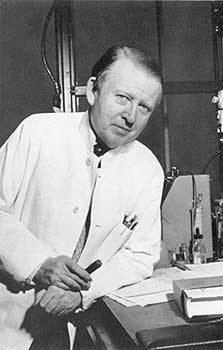Name Kaj Linderstrom-Lang | Role Scientist | |
 | ||
Born Kaj Ulrik Linderstrom-LangNovember 29, 1896 ( 1896-11-29 ) Died May 25, 1959, Copenhagen, Denmark | ||
Notable awards Royal Society (1956) | ||
Kaj Ulrik Linderstrøm-Lang (November 29, 1896 – May 25, 1959) was a Danish protein scientist, who was the director of the Carlsberg Laboratory from 1939 until his death.
Contents
- Early work
- Innovative methods
- Hydrogen deuterium exchange
- Contributions to protein structure and stability
- Contributions to other scientists
- Awards and honors
- References

His most notable scientific contributions were the development of sundry physical techniques to study protein structure and function (especially hydrogen–deuterium exchange), and his definitions of protein primary, secondary, tertiary and quaternary structure.
Linderstrøm-Lang devoted himself unstintingly to protein science and trained a whole generation of eminent protein scientists, Linderstrøm-Lang maintained a fun atmosphere in his laboratory and a happy spirit that expressed itself in wonderful Christmas parties and frequent trips to the Tivoli amusement park in Copenhagen. Linderstrøm-Lang was also a writer, musician and story-teller, and was active in the resistance movement against the Nazi occupation of Denmark.
Early work
Linderstrøm-Lang began as a physicist. Only a year after the publication of the Debye–Hückel theory, Linderstrøm-Lang applied it to proteins and contributed in defining the term isoionic point. In particular, he formally considered the ensemble of protonation states. Linderstrøm-Lang began in the Carlsberg laboratory under its second director S. P. L. Sørensen (who invented the pH scale). 1949 volumetric studies showing that the interior of proteins has very few charges and, hence, is likely to be hydrophobic.
Innovative methods
Perhaps the most elegant method developed by Linderstrøm-Lang is the Cartesian diver for measuring density. A long tube containing oils of gradually increasing density was prepared. A droplet containing a protein mixture is introduced and falls until it reaches its density. Very small changes in the density of the droplet (e.g., those due to an ongoing enzymatic reaction) could be observed by movements of the droplet in the density gradient.
Hydrogen-deuterium exchange
Kaj Ulrik Linderstrøm-Lang is considered the father of hydrogen–deuterium exchange.
Contributions to protein structure and stability
Linderstrøm-Lang is justly famous for his organization of protein structure into four levels: primary, secondary, tertiary and quaternary structure. He did so in his Lane Medical Lectures, which were delivered at Stanford University in 1951 on October 2, 4, 8, 10 and 12, and later published by Stanford University Press.
Contributions to other scientists
Linderstrøm-Lang contributed to the training of a whole generation of protein scientists, such as Frederic M. Richards, H. A. Scheraga, Christian B. Anfinsen, William F. Harrington, etc. He is also credited with the insight that the free energy of hydrophobic interactions does not depend only on energy (but also entropy), from his realization that mixing water and alcohol (which contains a hydrophobic methyl group) gives off heat.
Awards and honors
Linderstrøm-Lang was elected a Foreign Member of the Royal Society (ForMemRS) in 1956.
